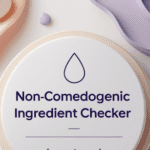Comedogenic Ingredient Checker
Have you ever wondered why some skincare products leave your skin feeling clean but still cause breakouts? The answer might lie in something called comedogenic ingredients. If that sounds like a science-y term, don’t worry; it’s simpler than it seems. Comedogenic ingredients are those that have the potential to clog your pores, leading to blackheads, whiteheads, or even full-blown acne. And unfortunately, they can hide in plain sight in many of the products we use every day.
There’s no need to guess whether a skincare product can clog pores anymore. That’s where our pore-clogging ingredients checker comes in! This free tool is designed to help you take control of your skincare routine by identifying which ingredients might be causing trouble for your skin.
So, how does it work? It’s as simple as entering an ingredient name or pasting a product’s full ingredient list into the tool. Within seconds, you’ll get clear results showing whether each ingredient has a comedogenic rating. The results are reliable, backed up by Fulton’s research list of comedogenic ingredients.
Why You Should Always Use a Pore-Clogging Ingredient Checker
Skincare can be confusing. Have you ever stood in front of a skincare aisle wondering which product to choose? Or worse, tried something new only to end up with unexpected breakouts? If you’ve been there, you’re not alone. The good news is, a pore.clogging ingredients checker can help simplify things for you. Here’s why you should always have one in your skincare arsenal:
1. Say Goodbye to Unexpected Breakouts
One of the biggest frustrations with skincare is realizing that a product causes breakouts after you’ve already used it. Comedogenic ingredients are often hiding right there on the ingredient list. A pore-clogging ingredients checker takes the guesswork out of this process by flagging potential problem ingredients before you even buy the product.
2. Save Time and Money
We’ve all wasted money on products that didn’t work—or worse, made our skin worse. You can check for pore clogging ingredients with this tool and avoid the trial-and-error shopping.
3. Decode Those Tricky Ingredient Lists
Ever looked at a skincare label and thought, “What language is this written in?” A pore-clogging ingredient checker does all the hard work for you. Just input an ingredient or paste an entire list, and the tool will highlight any comedogenic offenders within seconds.
4. Tailor Your Routine to Your Unique Skin
Every person’s skin is different. What works for one person might not work for another. A checker helps you personalize your skincare routine so you can choose products that complement your complexion instead of compromising it.
5. Trust Science-Backed Data
The ratings provided by a pore-clogging ingredients check are based on real scientific research from trusted sources like dermatological studies and reputable organizations. This means you can trust the information and make decisions confidently, knowing you’re backed by solid evidence.
6. Discover Safer Alternatives
If the checker flags an ingredient as potentially problematic, don’t worry; it often suggests safer alternatives. For example, if coconut oil (which has a high comedogenic rating) shows up as a concern, the tool might recommend jojoba oil instead. Jojoba oil is non-comedogenic and mimics your skin’s natural sebum, making it a great choice for acne-prone skin. These recommendations empower you to explore better options for your skin.
| Ingredient | Comedogenic Grade |
|---|---|
| Coconut Oil | 4 |
| Shea Butter | 0-2 |
| Olive Oil | 2 |
| Almond Oil | 2 |
| Avocado Oil | 3 |
| Jojoba Oil | 2 |
| Grapeseed Oil | 1 |
| Sunflower Oil | 0 |
| Argan Oil | 0 |
| Castor Oil | 1 |
| Lanolin | 4 |
| Mineral Oil | 0 |
| Beeswax | 2 |
| Wheat Germ Oil | 5 |
| Isopropyl Myristate | 5 |
| Stearic Acid | 2 |
| Palmitic Acid | 2 |
| Squalane | 1 |
| Cocoa Butter | 4 |
| Marula Oil | 3 |
What Is the Pore-Clogging Ingredient Checker?
A pore-clogging ingredient checker is a simple yet powerful database that contains over 300+ ingredients, each with a comedogenic rating from 0 to 5. These ratings tell you how likely an ingredient is to clog your pores—0 being “no risk” and 5 being “high risk.”
Here’s how it works: You can either type in a single ingredient (like “coconut oil”) or paste an entire product ingredient list. The tool will scan through the list, highlight any comedogenic offenders, and provide clear explanations of what those ratings mean for your skin.
Key Features That Make It Stand Out
-
Instant results: No more waiting around or sifting through long ingredient lists. Just enter the info, hit “Check,” and voilà—you’ve got your answers in seconds.
-
Clear explanations: Each result comes with a straightforward explanation of the comedogenic rating. For example, if you search for “coconut oil,” you’ll learn that it has a rating of 4, meaning it’s highly likely to clog pores. But don’t worry—we also explain why some people tolerate it better than others.
-
Links to deeper insights: If you’re curious to learn more about a specific ingredient, the tool provides links to related blog posts on our site. For instance, if you check “aloe vera” and want to dive deeper, we’ll point you toward this article where we break down everything you need to know about its comedogenic rating. Same goes for other popular ingredients like coconut oil, argan oil, or cocoa butter.
How Does the Tool Work?
Let’s break it down step by step so you can see just how easy it is to do a pore clogging ingredients check. This tool is designed to be simple and straightforward, even if skincare science feels a little overwhelming at times. Here’s everything you need to know:
Step 1: Input Your Ingredient or Paste an Ingredient List
The first thing you’ll do is head over to the checker on our website. Once there, you’ll find a clean and user-friendly interface with a search bar waiting for your input. You have two options here:
-
Option 1: Type in the name of a single ingredient you’re curious about (like “coconut oil” or “aloe vera”).
-
Option 2: If you’ve got a whole product label handy, paste the entire list of ingredients into the box. The tool will scan through all of them at once and highlight any potential pore-cloggers.
Step 2: Click “Check”
Once you’ve entered your ingredient(s), simply click the big green “Check” button. That’s it! The tool will work its magic behind the scenes, scanning our extensive database of over 100+ ingredients to identify anything that might cause issues for your skin.
Step 3: View Your Results
In seconds, you’ll get clear and concise results right on your screen. For each flagged ingredient, the tool will show:
-
Its comedogenic rating (from 0 to 5, where 0 means no risk and 5 means high risk).
-
A brief explanation of what the rating means and why it matters for your skin.
For example, if you check “Coconut Oil,” the result might look something like this:
Coconut Oil (Comedogenic Rating: 4) Coconut oil is highly likely to clog pores due to its thick consistency. While some people tolerate it well, others may experience breakouts. Learn more about whether coconut oil works for your skin here .
If the tool finds multiple comedogenic ingredients in a product list, it’ll list them out one by one, making it super easy to understand which ones could be problematic.
Ingredient List Parser Example
Output:
- Coconut Oil: 4
- Shea Butter: 2
Legend:Green = Safe Ingredients
Red = Risky Ingredients
Example Walkthrough
Let’s walk through a quick example together. Say you’re wondering about the safety of coconut oil. Here’s how the process would go:
-
You type “Coconut Oil” into the search bar.
-
You hit “Check.”
-
Within moments, the tool tells you:
Coconut Oil (Comedogenic Rating: 4) Coconut oil has a high comedogenic rating, meaning it’s likely to clog pores (According to acne.org). If you’re prone to acne or blackheads, you might want to consider alternatives like jojoba oil. Want to dive deeper? Check out this article for more details.
What Happens Next?
After reviewing your results, the tool gives you options to explore further. Depending on the ingredients you checked, you’ll see links to related blog posts on our site. These articles provide even more insights, tips, and alternatives to help you make informed decisions.
Before-and-After Comparison Chart
| Product | Ingredients | Result |
|---|---|---|
| Product A | Coconut oil (rating 4), Cocoa butter (rating 4) | Likely to cause breakouts for acne-prone skin. |
| Product B | Jojoba oil (rating 0), Aloe vera (rating 1) | Safe for most skin types. |
Purpose: Demonstrates the importance of checking ingredients and choosing safer alternatives.
-
If you check “Aloe Vera,” we’ll point you toward this post to explain its benefits and risks.
-
If you’re curious about “Argan Oil,” you’ll find a link to this guide for all the details.
“Our tool simplifies the process and empowers you to make informed decisions about your skincare.”
Related Blog Posts and CTAs
Once you’ve used the pore-clogging ingredient checker, we don’t want you to stop there! Depending on what the tool flagged, we’ve got some extra resources to help you dive deeper into specific ingredients or topics. Think of these as your next steps toward building a skincare routine that works for you.
Dynamic CTAs Based on Your Results
If the checker flagged coconut oil, for example, you might see this message:
“Still curious? Read more about coconut oil here” → [Link to https://greenglowguide.com/is-coconut-oil-comedogenic/] .
Or, if Aloe Vera showed up in your results:
“Learn more about aloe vera’s comedogenic properties here” → [Link to https://greenglowguide.com/is-aloe-vera-comedogenic/] .
We know every ingredient is unique, and sometimes a quick rating isn’t enough to answer all your questions. That’s why we provide links to detailed articles where we break down everything you need to know—benefits, risks, and even alternatives.
Even if the tool didn’t flag anything major (or if you’re just hungry for more info), we’ve got plenty of other content to keep you learning. Here are a few suggestions:
-
Non-Comedogenic Oils : Not sure which oils are safe for acne-prone skin? We’ve got you covered with a list of top picks. (Coming soon!)
-
Acne-Safe Moisturizers : Struggling to find a hydrating product that won’t trigger breakouts? Check out our guide to choosing the best moisturizer for your skin type. (Coming soon!)
-
Ingredient Spotlights : Want to learn more about ingredients like Argan Oil , Cocoa Butter , or Jojoba Oil ?
Click below to explore their comedogenic ratings and how they affect different skin types:
Why Keep Exploring?
So go ahead—click around, read up, and get inspired. And remember, your skin journey doesn’t have to be complicated. With tools like the Pore-Clogging Ingredient Checker and expert guides at your fingertips, clearer skin is closer than you think!

I’m a devoted organic skincare enthusiast, passionate about the natural, wholesome goodness that organic products bring to our skin.
Organic skincare isn’t just a hobby for me—it’s a lifestyle. Every product I use, recommend, and write about has been carefully chosen for its purity and effectiveness. Everything I write about is backed by scientific studies, dermatologists’ opinions, and user experiences.
I also excel at tackling skincare challenges with innovative, organic solutions.

